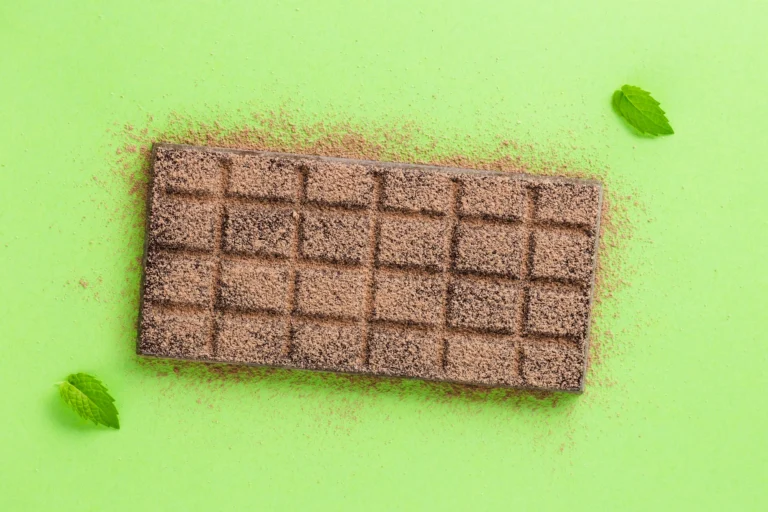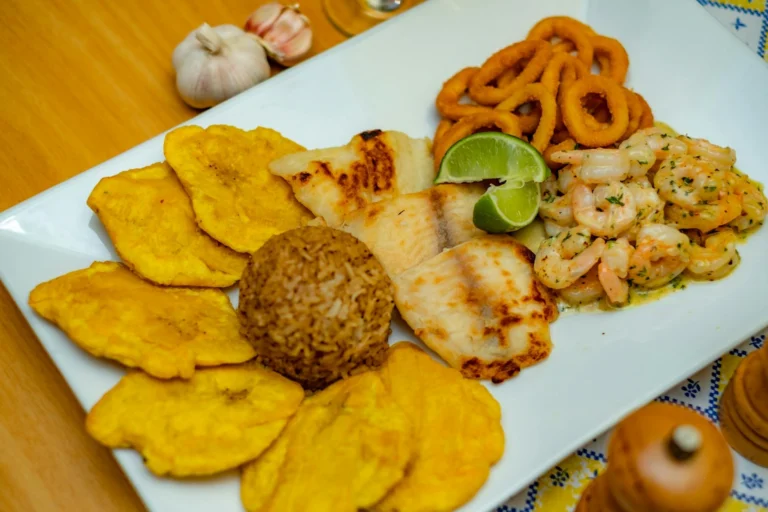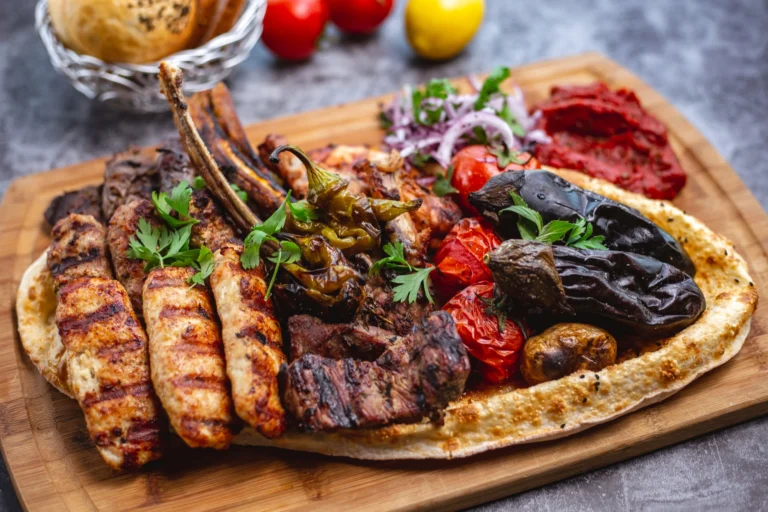15 Best Ecuadorian Food Dishes You Must Try
Are you ready to embark on a flavorful adventure through one of South America’s most diverse culinary landscapes? As someone who’s spent countless hours exploring Ecuador food scene, I can tell you that Ecuadorian food is more than just sustenance – it’s a celebration of culture, history, and incredible flavors that will leave you craving more.
When I first discovered Ecuador foods, I was blown away by how each region tells its own unique story through its dishes. From the coastal delicacies to the hearty Andean classics, Ecuadorian culture food represents a fascinating tapestry of indigenous traditions and colonial influences. Whether you’re a curious foodie or an adventurous traveler, these Ecuadorian meals will take your taste buds on an unforgettable journey.
The Three Culinary Regions of Ecuador: A Feast for Your Senses
Before we dive into specific dishes, let me paint you a picture of Ecuador’s remarkable culinary landscape. The country’s Ecuador food scene is divided into three distinct regions, each offering its own spectacular flavors:
The Coastal Kitchen (La Costa)
Picture yourself walking through a bustling market in Guayaquil, where the air is filled with the aroma of fresh seafood and tropical fruits. The coastal region specializes in seafood-based dishes that will make any fish lover’s heart skip a beat. Here, ceviche isn’t just food – it’s an art form.
The Andean Heights (La Sierra)
As we climb into the mountains, the cuisine transforms dramatically. This is where you’ll find hearty, warming dishes that have sustained generations of highland communities. The starring ingredients? Potatoes in countless varieties, corn in all its forms, and unique proteins that might surprise you.
The Amazon’s Abundance (La Amazonía)
Venture into the Amazon, and you’ll discover flavors you never knew existed. This region’s cuisine is perhaps the most authentic representation of pre-colonial Ecuadorian food, featuring exotic fruits, river fish, and indigenous cooking techniques that have remained unchanged for centuries.
Must-Try Traditional Ecuadorian Dishes
1. Ceviche: Ecuador’s Coastal Pride
Let’s start with everyone’s favorite – ceviche. While Peru might be famous for this dish, Ecuadorian ceviche has its own distinctive character. Made with fresh shrimp, fish, or a mixture of seafood, it’s marinated in lime juice and served with popcorn or plantain chips. The secret? We add tomato sauce to create a slightly different flavor profile that’s absolutely addictive.
2. Llapingachos: The Cheesy Comfort Food
These cheese-stuffed potato patties are pure comfort food. Golden-crispy on the outside and perfectly gooey on the inside, llapingachos are often served with peanut sauce, avocado, and a fried egg. Trust me, once you try these, you’ll understand why they’re a national treasure.
3. Hornado: A Feast for the Ages
Imagine a whole pig slow-roasted to perfection, its skin crackling and meat so tender it falls off the bone. That’s hornado for you. Served with llapingachos, mote (hominy), and agrio (a tangy sauce), it’s a dish that brings families together and features prominently in local food festivals.
4. Locro de Papa: The Andean Hug in a Bowl
When the mountain mist rolls in, there’s nothing more comforting than a bowl of locro de papa. This creamy potato soup, enriched with cheese and avocado, is a perfect example of how simple ingredients can create something extraordinary. For vegetarians exploring Ecuadorian cuisine, this is a must-try option.
Street Food Adventures: A Taste of Local Life
The streets of Ecuador are a food lover’s paradise. From quick bites to hearty snacks, here’s what you shouldn’t miss:
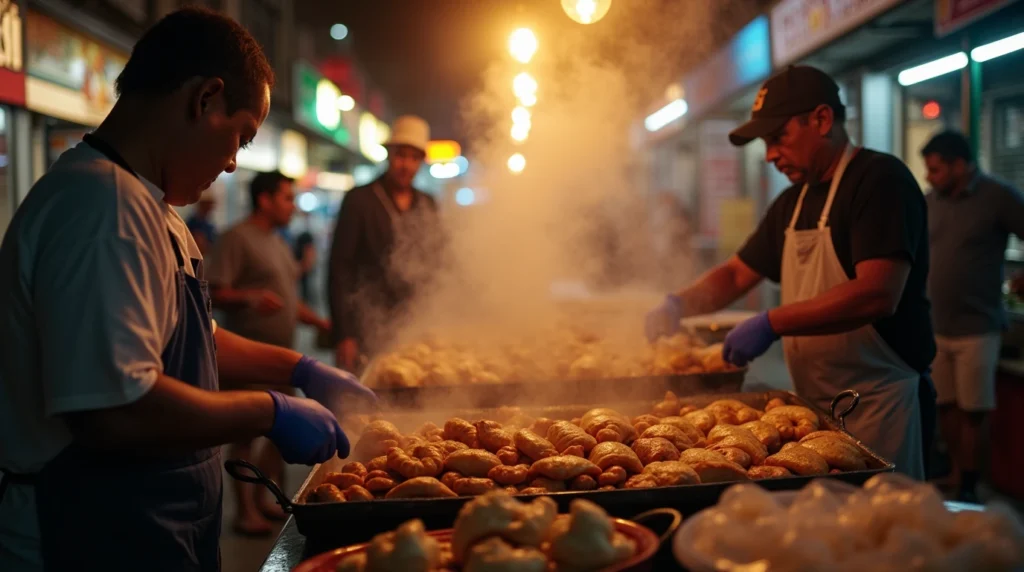
1. Empanadas de Viento
These cheese-filled pastries are aptly named “wind empanadas” because they puff up when fried. Sprinkled with sugar, they’re the perfect balance of savory and sweet.
2. Salchipapas
Sometimes the simplest things are the best. This popular street food combination of french fries and sliced hot dogs, drowned in various sauces, is Ecuador’s answer to late-night cravings.
Regional Specialties You Can’t Miss
Coast:
- Encebollado: A traditional fish soup that’s famous as a hangover cure
- Cazuela: A seafood casserole cooked in a clay pot
Andes:
- Cuy: Yes, guinea pig! It’s a delicacy that’s been enjoyed since pre-Columbian times
- Fanesca: A special soup made during Holy Week containing twelve different grains
Amazon:
- Maito: Fish wrapped in banana leaves and grilled to perfection
- Chontacuro: For the adventurous eater, these palm tree grubs are a traditional protein source
The Cultural Significance of Ecuadorian Food
Food in Ecuador is more than sustenance – it’s a way of life. Family gatherings, festivals, and celebrations all revolve around traditional dishes. The almuerzo (lunch) tradition, where families come together for a multi-course meal, remains an important part of daily life.
Modern Ecuadorian Cuisine: Tradition Meets Innovation
While traditional cooking methods in Ecuador remain strong, a new generation of chefs is reimagining classic dishes. In cities like Quito and Cuenca, you’ll find restaurants blending ancient ingredients with modern techniques, creating exciting new interpretations of traditional favorites.
Tips for Exploring Ecuadorian Cuisine
- Don’t miss the food markets! Places like Mercado Central in Quito offer authentic experiences
- Try the local fruits – you’ll discover flavors you never knew existed
- Embrace the spice – ají (hot sauce) is a constant companion at Ecuadorian tables
- Remember that lunch is the main meal of the day
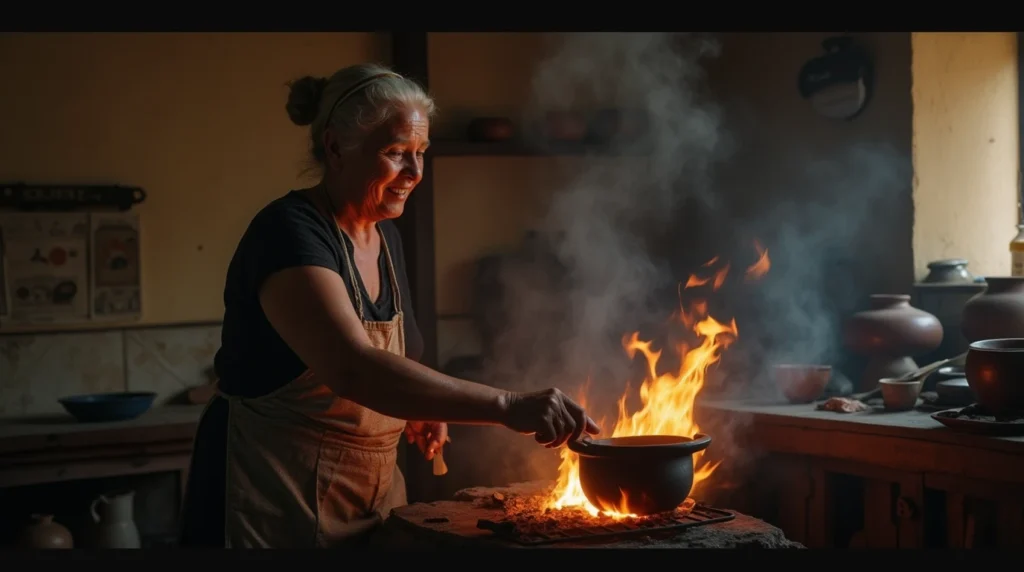
Traditional Ingredients That Make Ecuadorian Food Special
- Green plantains (plátano verde)
- Various types of corn (choclo, morocho, etc.)
- Yuca (cassava)
- Fresh seafood
- Andean potatoes in countless varieties
Nutritional Value of Traditional Ecuadorian Dishes
Many traditional Ecuadorian dishes offer a balanced combination of proteins, complex carbohydrates, and healthy fats. The use of fresh, local ingredients and various cooking methods helps preserve the nutritional value of the food.
Where to Find the Best Ecuadorian Food
Local Markets
- Mercado Central (Quito)
- Mercado 9 de Octubre (Cuenca)
- Mercado de Santa Clara (Quito)
Traditional Restaurants
Look for “huecas” – small, family-run establishments that often serve the most authentic food.
Traditional Ecuadorian Cooking Methods
Understanding traditional cooking methods helps appreciate the complexity of Ecuadorian cuisine:
Earth Ovens (Pachamanca)
Dating back to Incan times, this method involves cooking food in an earthen pit with hot stones. Meats, vegetables, and herbs are layered carefully, resulting in incredibly tender and flavorful dishes.
Clay Pot Cooking
Many traditional dishes are prepared in clay pots, which add a distinct earthy flavor. The porous nature of clay allows for even heat distribution and moisture retention, making it perfect for stews and soups.
Wrapping in Leaves
Banana and bijao leaves are commonly used to wrap food before cooking, a method that infuses dishes with subtle flavors while keeping them moist.
Food Festivals and Celebrations
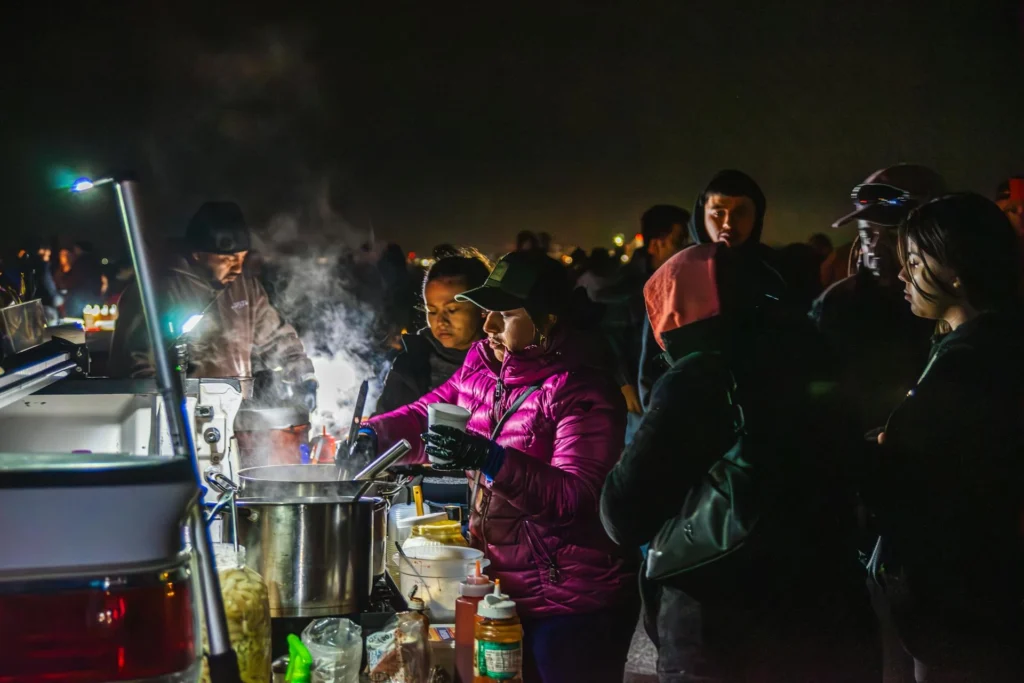
Carnival
During carnival season, communities gather to prepare and share traditional dishes like hornado and chicha (fermented corn beverage).
Corpus Christi
This festival features unique bread figures and traditional sweets, showcasing Ecuador’s Spanish colonial influence on its cuisine.
Inti Raymi
The sun festival celebrates harvest season with special dishes made from corn and potatoes, honoring indigenous agricultural traditions.
Modern Influences on Ecuadorian Cuisine
International Fusion
Contemporary Ecuadorian chefs are creating innovative dishes that blend traditional ingredients with international cooking techniques.
Health-Conscious Adaptations
Traditional recipes are being modified to accommodate modern dietary preferences while maintaining authentic flavors.
Sustainability Practices
There’s a growing movement to preserve traditional farming methods and indigenous ingredients, ensuring these culinary traditions continue.
Essential Kitchen Tools in Ecuadorian Cooking
- Piedra de Moler (Grinding Stone)
- Clay Pots
- Wooden Spoons
- Banana Leaf Wrappers
- Traditional Grills
Frequently Asked Questions About Ecuadorian Food
What are the most popular dishes in Ecuador?
The most beloved Ecuadorian dishes include ceviche (seafood marinated in citrus), llapingachos (cheese-stuffed potato patties), hornado (roasted pork), and locro de papa (potato soup). Each region has its specialties, but these dishes are universally loved throughout the country.
What ingredients are commonly used in Ecuadorian cuisine?
Ecuadorian cooking relies heavily on:
- Potatoes (especially in the Andes)
- Rice (a staple in most meals)
- Plantains (both green and ripe)
- Yuca (cassava)
- Various meats (pork, chicken, beef)
- Fresh seafood (in coastal regions)
- Indigenous grains like quinoa
- Local spices and herbs
How does Ecuadorian food vary by region?
The regional variation in Ecuadorian cuisine is remarkable:
- Coastal Region: Focuses on seafood dishes, tropical fruits, and coconut-based preparations
- Andean Region: Features potatoes, corn, and hearty meat dishes
- Amazon Region: Utilizes exotic fruits, river fish, and traditional cooking methods
What is traditional Ecuadorian ceviche and how is it prepared?
Ecuadorian ceviche differs from other Latin American versions:
- Uses pre-cooked seafood (usually shrimp)
- Includes tomato sauce or ketchup
- Served with popcorn or plantain chips
- Often includes a mixture of lime juice, onions, and cilantro
- Can be made with fish, shrimp, or mixed seafood
Are there vegetarian options in Ecuadorian cuisine?
Yes, there are numerous vegetarian options:
- Locro de papa (potato soup)
- Vegetarian empanadas
- Morocho (sweet corn drink)
- Plantain-based dishes
- Bean and grain-based soups
- Quinoa dishes
What is the significance of llapingachos in Ecuadorian culture?
Llapingachos represent:
- A staple of highland cuisine
- Family traditions and cooking methods
- Cultural fusion of indigenous and colonial influences
- National pride in local ingredients
- Community gathering and sharing
Is cuy (guinea pig) really common in Ecuador?
Cuy is:
- Considered a delicacy
- Mainly served in the Andean region
- Often prepared for special occasions
- Roasted whole with herbs and spices
- An important part of indigenous culture
What are typical Ecuadorian meal structures?
A traditional Ecuadorian meal includes:
- Soup as a starter
- Main course with protein, rice, and vegetables
- Fresh fruit juice
- Sometimes dessert
- Often served family-style
What popular street foods can I find in Ecuador?
Popular street foods include:
- Salchipapas (french fries with sausage)
- Empanadas (various fillings)
- Plantain chips
- Corn on the cob
- Roasted pork sandwiches
How has traditional Ecuadorian cuisine evolved in modern times?
Modern Ecuadorian cuisine shows:
- Fusion with international cooking styles
- Health-conscious adaptations
- Preservation of traditional methods
- Innovation in presentation
- Growing international recognition
Conclusion: A Culinary Heritage Worth Exploring
Ecuadorian food is a testament to the country’s rich cultural heritage and biodiversity. From the coast to the highlands to the Amazon, each region offers unique flavors and preparations that tell the story of Ecuador’s people and history. Whether you’re planning a trip or just wanting to expand your culinary horizons, Ecuadorian cuisine offers an adventure your taste buds won’t forget.
Ready to start your own Ecuadorian food journey? Begin with simple dishes like locro de papa or llapingachos, and gradually work your way up to more adventurous options. Remember, the best way to experience any cuisine is with an open mind and a hungry heart!


